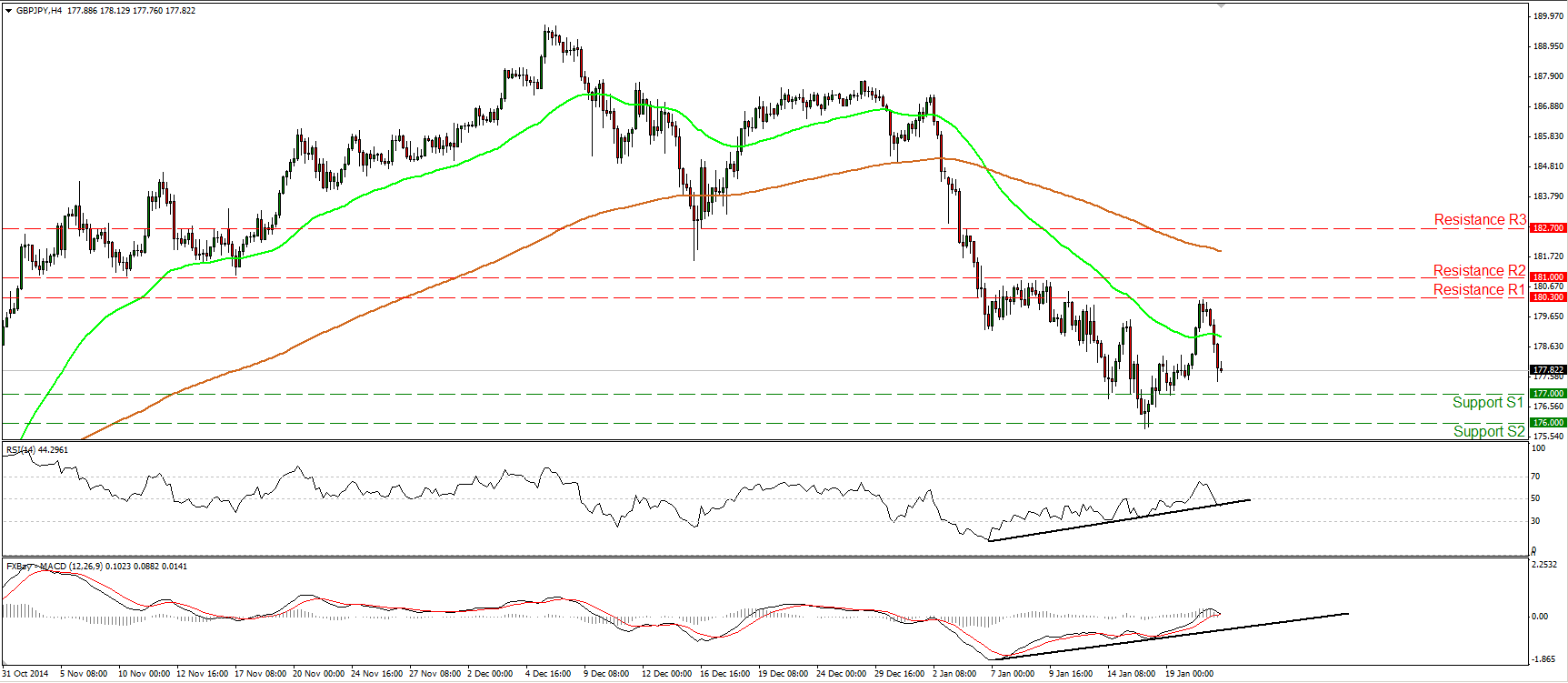GBP/JPY
The dollar trade mixed against its major counterparts during the European morning Wednesday. It was higher against NZD, AUD and GBP, in that order, while it was lower against CHF, NOK, SEK and JPY. The greenback was stable vs EUR and CAD.
The Bank of England policy meeting minutes revealed that the policy makers are no longer divided over policy. The MPC members voted unanimously to keep rates on hold, after the two policymakers who since August had been voting for a rate hike dropped their call in the face of falling inflation. They switched their stance because they now believe there is a risk that below-target inflation may persist. The UK CPI rate declined to +0.5% yoy in December and could even turn negative in the coming months, pulled mainly by lower oil prices and also lower inflation feeding through to lower wage settlements, helping to depress price increases further. Even though the central bank saw no need for further stimulus and still plans to raise rates within the foreseeable future, expectations are getting pushed back even further, leaving GBP vulnerable, in our view.
At the same time, the UK unemployment rate declined to 5.8% in November from 6.0% previously and average weekly earnings including bonuses rose 1.7% yoy, up from +1.4% yoy in October. Wage growth outpaced inflation and suggested less slack in the labor market. Normally this would strengthen GBP, but given the switch in MPC votes, GBP/USD plunged to find buy orders near our 1.5075 support line, while EUR/GBP firmed up to find resistance near 0.7700. We could view the surge in EUR/GBP short-lived given the Eurozone’s weaker fundamentals, as for Cable we would wait for a break below 1.5000 to get confident for further declines.
GBP/JPY fell sharply after hitting resistance around 180.30 (R1). At midday in Europe, the rate is heading towards our support barrier of 177.00 (S1), where a break could challenge again the 176.00 (S2) line. The RSI fell below its 50 line and could now move below its black upside support line, while the MACD has topped and could move below both its zero and signal lines any time soon. These signs confirm today’s negative momentum and support the case for further declines in the short term. On the daily chart, the picture stays cautiously negative. I would like to see a move below the 176.00 (S2) area and the 200-day moving average before trusting that medium term down path again. It is worth noting that the 176.00 (S2) area coincides with the 61.8% retracement level of the 15th of October – 5th of December rally and also with the 161.8% extension level of the width of a failure swing top completed on the 6th of January.
Support: 177.00 (S1), 176.00 (S2), 174.60 (S3)
Resistance: 180.30 (R1), 181.00 (R2), 182.70 (R3)
Recommended Content
Editors’ Picks
AUD/USD could extend the recovery to 0.6500 and above

The enhanced risk appetite and the weakening of the Greenback enabled AUD/USD to build on the promising start to the week and trade closer to the key barrier at 0.6500 the figure ahead of key inflation figures in Australia.
EUR/USD now refocuses on the 200-day SMA

EUR/USD extended its positive momentum and rose above the 1.0700 yardstick, driven by the intense PMI-led retracement in the US Dollar as well as a prevailing risk-friendly environment in the FX universe.
Gold struggles around $2,325 despite broad US Dollar’s weakness

Gold reversed its direction and rose to the $2,320 area, erasing a large portion of its daily losses in the process. The benchmark 10-year US Treasury bond yield stays in the red below 4.6% following the weak US PMI data and supports XAU/USD.
Bitcoin price makes run for previous cycle highs as Morgan Stanley pushes BTC ETF exposure

Bitcoin (BTC) price strength continues to grow, three days after the fourth halving. Optimism continues to abound in the market as Bitcoiners envision a reclamation of previous cycle highs.
US versus the Eurozone: Inflation divergence causes monetary desynchronization

Historically there is a very close correlation between changes in US Treasury yields and German Bund yields. This is relevant at the current juncture, considering that the recent hawkish twist in the tone of the Federal Reserve might continue to push US long-term interest rates higher and put upward pressure on bond yields in the Eurozone.
